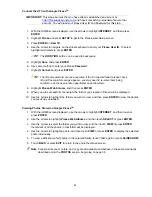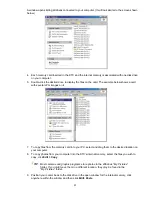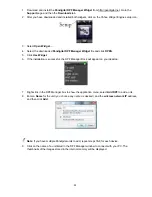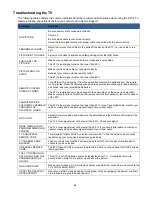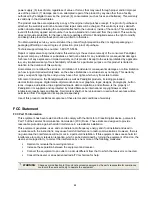
67
Problems
Solutions
HDCP VIDEO HAS NO
AUDIO
Make sure you have a 3.5 mm mini-jack cable connected from your HDCP video device’s
sound output to the TV’s VGA STEREO INPUT. If your HDCP video device uses RCA
AUDIO jacks, you’ll need the RCA audio converted into 3.5 mm mini-jack cable.
CANNOT GET 1440x900
ON PC VGA
1440x900 is a widescreen resolution. If your video card cannot achieve the resolution, try
updating the video card’s drivers to the newest version. If that does not work, you’ll need to
think about upgrading the video card to one that is capable of achieving that resolution.
PICTURE IS DISTORTED
OR HAS ABNORMAL
SOUND
This might be from interference from large electrical appliances, cars, motorcycles, or
fluorescent lights. If the KTC is close to the wall, try moving it to another room in your
house.
PICTURE DOES NOT
COVER THE ENTIRE
SCREEN
If you’re using HDMI or a TV digital channel make sure you set the ASPECT ratio to FULL
format. If you are using VGA, use the AUTO ADJUST function to adjust to the screen. If you
are using a regular analog TV, AV, or component in 480i resolution, set the ASPECT ratio
to FULL in order to fill up the screen.
Note
: this setting will distort the picture.
SWITCHING A CHANNEL
OR SOURCE CHANGES
THE VOLUME
Different channels and inputs will sometimes have this effect because the channel signal’s
own volume is already loud. There is no way remove this completely. The KTC has an
AUTO VOLUME LEVEL function that can combat this type of effect; make sure that function
is turned on.
THERE IS NOISE OR
TRASH PIXELS ON THE
SCREEN
When your KTC’s resolution is higher than the digital channel’s broadcast resolution, the
signal is up-converted to match your TV’s resolution. Up-converting can cause this type of
effect.
TIPS FOR HIGH
DEFINITION USERS
The KTC is an ideal platform for viewing High Definition Content. The best image quality can
be achieved by HDMI, YPbPr (Component), then VGA. However, due to variances in
broadcast practices, it is possible some image distortions can occur.
TIPS FOR LETTERBOX
CONTENT USERS
Letterboxed (Widescreen) versions of DVD movies are most commonly formatted for
standard 4:3 TVs. The KTC has the capability of expanding this content so the entire screen
is filled at the expense of the image proportion. To use this function press the aspect button
on the remote control and cycle among the available options.
I CANNOT FIND THE
VOLUME AND CHANNEL
CHANGING BUTTONS
On the remote control, the
VOL-, VOL+
buttons adjust the volume and the
CH-
and
CH+
buttons change the channels.
TV TURNS OFF
AUTOMATICALLY AFTER
5 MINUTES
When in TV mode, if left idle on a channel connection with very weak or no signal for 5
minutes, the KTC will automatically switch from TV mode to DPF mode and begin playing a
photo slideshow. This feature is present on all channel connections.
Limited Warranty
The limited warranty set forth below is given by Pandigital with respect to Pandigital brand electronics
products purchased and used in the United States of America. Pandigital warrants this product against
defects in material or workmanship as follows:
LABOR: For a period of one (1) year from the date of purchase, if this product is found to be defective,
Pandigital will repair or replace the product, at its option, at no charge. After this one (1) year, labor charges
will be charged on a case by case basis.
PARTS: For a period of one (1) year from the date of purchase, if this product is found to be defective,
Pandigital will supply at no cost, new or rebuilt replacement parts, at its option, at no charge. After this one (1)
year period, parts will be charged for on a case by case basis. Modifications not approved by the party
responsible for compliance could void user’s authority to operate the equipment.
This warranty does not cover: (1) customer instruction, installation or setup; (2) cosmetic damage or damage
due to accident, misuse, abuse or negligence; (3) commercial use of the product; (4) modification of any part
of the product; (5) damage due to improper operation, improper maintenance, or connection to an improper



